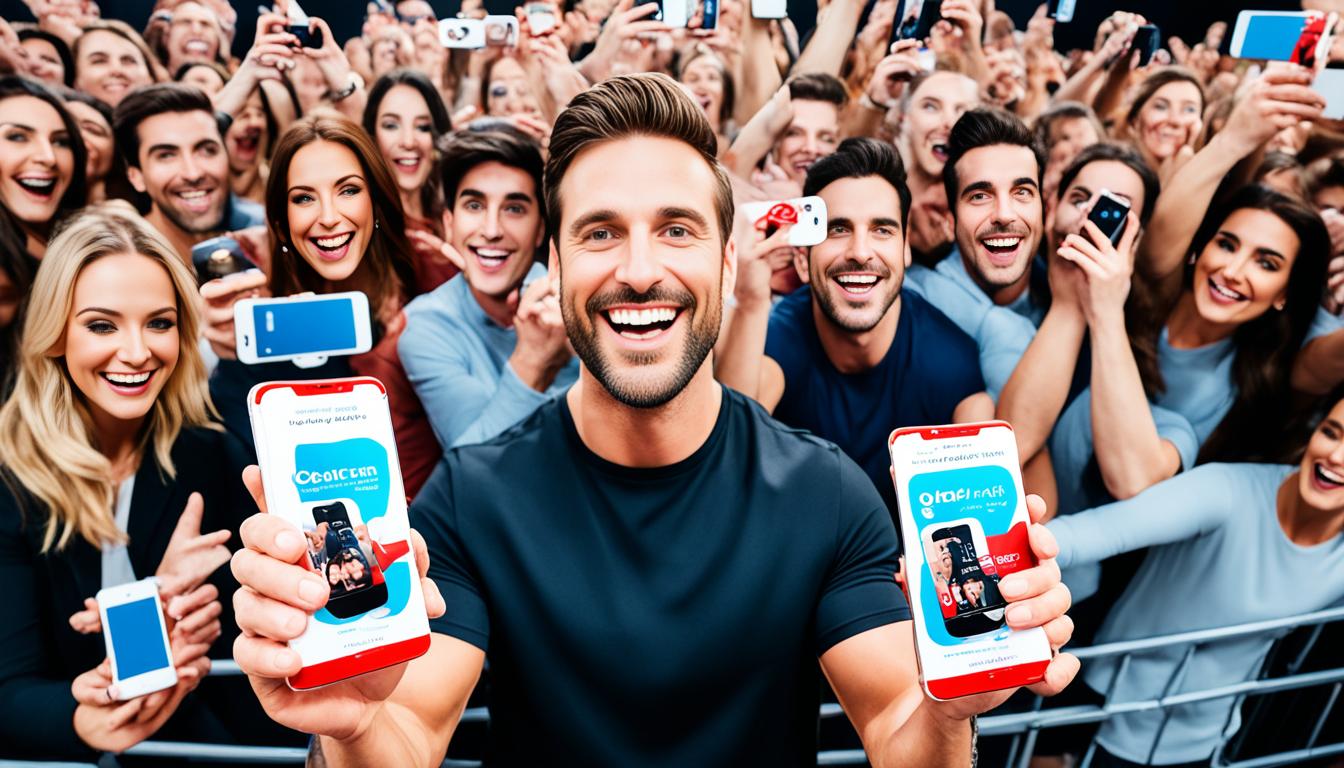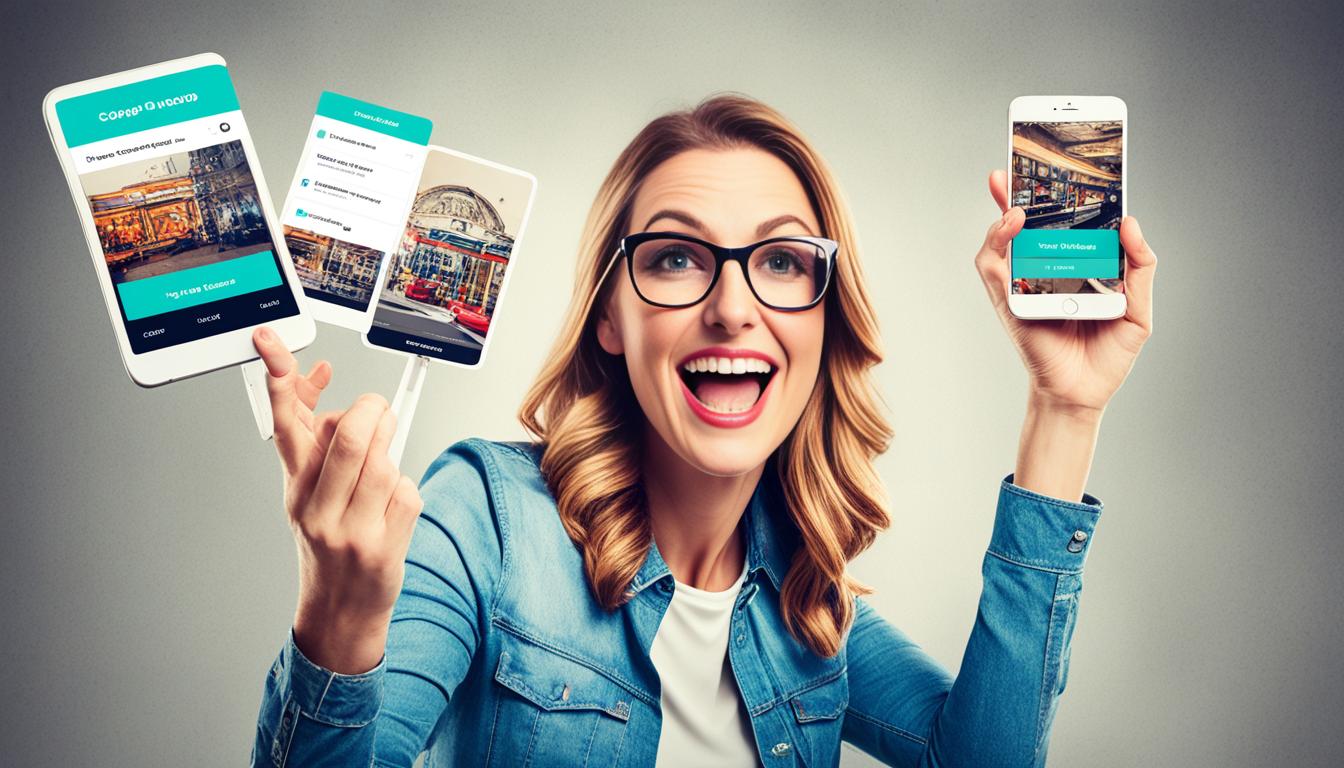Social Proof: What It Is & How To Use It Effectively
Leverage the Power of Social Proof: A Step-by-Step Guide
Did you know that 95% of shoppers check online reviews before buying something¹? This fact shows how big the impact of social proof is today. For business owners and marketers, using social proof can really help your brand stand out.
Social proof is when people follow others' actions. In marketing, it means looking at customer reviews and how people use products. It greatly affects what people decide to buy, with 83% of consumers telling their friends about brands they like on social media¹.
But it doesn't stop there. A huge 82% of Americans look for advice from friends before buying something¹. This shows how important social proof is in making buying decisions and building a good brand image.
Now, Instagram is a key place for social proof. Brands use it to show off what customers say, work with influencers, and share customer stories. Using social proof well can really help your marketing and increase sales.
Key Takeaways
95% of shoppers rely on online reviews before purchasing
Social proof significantly influences consumer behavior
83% of social media followers recommend brands to their network
Instagram is a powerful platform for showcasing social proof
Effective use of social proof can boost brand credibility and sales
User-generated content and influencer partnerships are valuable forms of social proof
Understanding the Concept of Social Proof
Social proof is a key idea in how we make choices. It affects how we see products, services, and brands. Let's look at its main parts and see how it changes our decisions.
Definition and Origin
Robert Cialdini first talked about "social proof" in his 1984 book. It means we often do what others do because we think it's right. This idea is now a big part of marketing, using our need to follow others.
Psychological Basis of Social Proof
The halo effect is a big part of social proof. It makes us see things in a good light because of one good thing. In marketing, this means a brand gets a positive image from its products. Social proof uses this effect to change how we think and decide.
Impact on Consumer Behavior
Social proof changes how people shop and what they think of brands. In fact, 83% of people trust advice from friends and family more than ads². This trust also applies to online reviews, with most shoppers reading a few reviews before buying³.
The effects of social proof can be seen in different ways:
Online Metrics Engagement Metrics
Likes, Comments, Shares: Positive reviews, Testimonials
Followers, Retweets: Brand hashtag frequency
Impressions, Clicks: Email subscriptions
Business Metrics
Likes, Comments, Shares: Products sold, New customers
Followers, Retweets: Referrals, Backlinks
Impressions, Clicks: Mobile app downloads
These numbers help businesses see if their social proof is working⁴. By using social proof, brands can use consumer psychology to grow and gain trust.
Types of Social Proof in Marketing

Social proof is a key tool in marketing that changes how people decide. It uses the fact that people often do what others do. Let's look at the main types of social proof and how they help in marketing.
Expert Social Proof
Expert social proof comes from recommendations by industry pros. When experts back a product, it gains trust. This kind of proof can really sway buying choices, as 93% of shoppers look at online reviews⁵.
Celebrity Endorsements
Celebrity endorsements are a big deal in social proof. When stars support a brand, they connect with consumers deeply. This method uses the wish to be like others, making products more appealing.
User Testimonials and Reviews
Customer reviews are key to social proof. They share real stories that buyers can see themselves in. In fact, 88% of people trust online reviews as much as personal tips⁶. Video testimonials work well too, with 42% finding them real and moving⁵.
Wisdom of the Crowd
This type of social proof is about what a big group thinks. It says if many people like something, it's likely good. Showing customer numbers or popular items taps into this idea.
Certification and Awards
Industry certifications and awards are strong social proof. They show skill and quality, making a brand more credible. Putting these on your site can build trust and sway buying choices.
Using social proof can really boost your marketing. From influencer marketing to customer reviews, each type has its own perks. By using these social proofs, you can gain trust, increase credibility, and boost sales.
The Power of Instagram Social Proof
Instagram is a giant in the world of social proof for digital marketing. It has 90% of users following at least one business and 83% using it to find new products. This makes it a great place for brands to show off what they offer⁷. The platform is great at sharing content that grabs people's attention and gets them involved.
User-generated content (UGC) is key to building trust on Instagram. When customers share their stories with your brand, it builds real social proof. This makes potential buyers more likely to trust you. Using branded hashtags can get lots of UGC, giving people a real look at what you offer⁸.
Visuals rule on Instagram, and using them well can really help your Instagram marketing grow. Sharing customer stories, showing off awards, and highlighting big moments can make people feel like they might miss out. For example, 75% of people always check out customer reviews, and good testimonials can increase sales by 34%⁹.
Influencer partnerships are also big for Instagram social proof. Micro-influencers can be especially strong supporters of your brand, sharing real tips with their followers⁷. When working with influencers, focus on being true to your brand to make the biggest impact on your social proof.
The secret to doing well on Instagram is to keep sharing content that matters to your audience. By using different types of social proof, you can build trust, show how valuable your product is, and increase sales on this lively platform.
Leveraging User-Generated Content (UGC)

User-generated content is a big deal for brands. It's a powerful tool that can boost your marketing and build trust with your audience. Let's dive into how you can use UGC to your advantage.
Encouraging UGC Creation
To get your customers involved, start with hashtag campaigns. Create a catchy, branded hashtag and ask your followers to use it when sharing their experiences. This simple step can lead to amazing results. Brands that actively encourage UGC see a 92% increase in engagement rates on Instagram¹⁰. It's not just about engagement - UGC can drive sales too. A whopping 75% of people have bought a product because they saw it on social media¹¹.
Curating and Showcasing UGC
Once you've collected UGC, it's time for content curation. Select the best submissions and showcase them on your social media profiles and website. This strategy pays off - posts that include UGC receive 28% higher engagement rates on Instagram¹⁰. Plus, brands leveraging UGC from social media can increase their conversion rates by 15% on average¹¹.
Legal Considerations for UGC
While UGC is valuable, it's crucial to respect UGC rights. Always obtain permission before using customer content and give proper credit to creators. This not only keeps you legally safe but also builds brand advocacy. Remember, 86% of consumers consider authenticity important when choosing brands to support¹⁰. By respecting your users' rights, you're showing that you value their contributions.
Implementing a UGC strategy can seem daunting, but the rewards are worth it. UGC is five times more likely to lead to a purchase compared to non-UGC material¹¹. So, start encouraging your customers to share their experiences - you might be surprised by the creative ways they showcase your brand.
Influencer Marketing as Social Proof
Influencer marketing is a strong way to build trust. It mixes famous people with real-life stories, making a big impact on what people buy. Working with influencers is now key for many brands.
Micro-influencers have changed the game. They have fewer followers but connect deeply with them. Brands are now choosing nano-influencers, those with 1,000 to 10,000 followers, more often. In 2024, 44% of brands will pick them, up from 39% in 2023¹².
Sponsored content can really work well. Almost half of consumers buy something from influencers every month. And 86% make a purchase at least once a year because of them¹². This shows how big an effect influencers have on what we buy.
For brands, it's important to find influencers that truly fit your brand. This builds trust and can lead to more sales. The influencer market is expected to grow to $24 billion by 2024, showing its success¹².
"Influencers are essential to our overall social media strategy."
More than 80% of marketers agree, according to a recent survey¹². Using influencers well can be a strong way to prove your brand's worth. It helps build trust and increase sales in a tough online market.
Case Studies: Successful Social Proof Campaigns

Social proof strategies are key in today's marketing. Let's look at some great marketing examples and success stories from various organizations.
Small Business Examples
Small businesses often use local influencers and customer feedback to gain trust. HelloFresh is a great example. They show real customer testimonials on their site, with names and photos. This builds a strong social proof effect¹³.
Large Corporation Strategies
Big companies often use famous people and user numbers in their ads. SEMrush, for example, has testimonials from big names like Quora and eBay. This shows how popular and useful their services are¹³. It's very effective, as 66% of people trust online reviews as much as personal advice¹⁴.
Non-Profit Organization Approaches
Non-profits often share stories of impact and feedback from those helped to build trust and get donations. They also use social proof like a blue checkmark on social media to show they're credible¹³.
In all areas, social proof's impact is clear. A huge 91% of people aged 18 to 34 trust online reviews as much as advice from friends¹⁴. Also, 79% of B2B buyers look at case studies when making decisions¹⁴.
Organization Type | Social Proof Strategy
Small Business: Customer Testimonials
Large Corporation: Brand Endorsements
Non-Profit: Certification Proof
Example
Small Business: HelloFresh landing page
Large Corporation: SEMrush testimonials
Non-Profit: Social media verification
These examples show how different organizations use social proof to build trust and engage with customers. It's clear that tailored strategies work well across various scales.
Integrating Social Proof in Website Design
Social proof is a key factor in making websites more effective. It builds trust and shows credibility¹⁵. In fact, 66% of people trust online reviews, and 95% look to others for product advice¹⁶.
To make your site more credible, consider these trust signals:
Customer reviews integration
Testimonials
Social media feeds
Case studies
Awards and certifications
Social proof widgets are great for showing real-time user actions. For instance, Grubthusiast uses social feeds to boost trust through live interactions¹⁷. Displaying purchase notifications can also make your site seem more popular and urgent.
Place trust badges strategically on your site. The Hirz Law Group shows off industry certifications and awards to look credible¹⁷. Featuring logos of well-known media outlets, like on Matt Mayberry's site, can also build trust¹⁷.
Remember, 54% of US shoppers check Google reviews when shopping offline¹⁶. Adding these reviews can give your site fresh content for search engines, helping with SEO¹⁵. By carefully adding social proof, you'll make your site more trustworthy and engaging for visitors¹⁵¹⁶¹⁷.
Social Proof in Email Marketing

Email marketing is still a key tool for businesses. Adding social proof can make it even more effective. By using customer testimonials, user stats, and media mentions, you can make emails that get more conversions and build trust.
Incorporating Testimonials in Emails
Customer testimonials are a strong form of social proof. Putting positive reviews in your emails can influence potential customers. Over 80% of buyers look at ratings and reviews before buying¹⁸. To make a bigger impact, use short, real testimonials that show the benefits of your product or service.
Showcasing User Statistics
Numbers are powerful. Sharing user stats in your emails shows your brand's success and popularity. You could talk about how many happy customers you have, projects you've done, or the revenue you've made. One email campaign got over 20,000 clicks with a live, showing how interactive social proof works¹⁹.
Highlighting Media Mentions
Being mentioned in the media and winning awards adds credibility to your brand. Showing these in your emails can impress potential customers and boost your reputation. Buyers need about 40 online reviews to trust a business's rating, so having different types of social proof is important²⁰.
Social Proof Type | Impact on Email Conversion Rates
Customer Testimonials: Can boost click-through rates significantly
User Statistics: Provides concrete evidence of brand popularity
Media Mentions: Enhances brand credibility and trust
By using these elements wisely, you can make email campaigns that use social proof to get more engagement and conversions. Remember, being real is important. Use true customer stories and real stats to build trust with your audience.
Measuring the Effectiveness of Social Proof
It's key to track social proof metrics to see how it affects your marketing. By watching important signs, you can see if your social proof plans are working. This helps you make smart choices to boost your conversion rate optimization.
Customer reviews are a big part of social proof. Studies show 55% of customers look at reviews before buying, and 93% read reviews online first²¹. This shows how important it is to show good customer feedback on your site and product pages.
User-generated content (UGC) also greatly affects buying decisions. Over 55% of shoppers look at UGC like reviews and photos before buying²². The average eCommerce site sees a 161% boost in conversion rates with UGC, with fashion seeing a 207% boost²².
To see how well your social proof works, look at these key metrics:
Conversion rates
Engagement levels
Brand sentiment
Customer feedback and surveys
Doing A/B tests can show you the best social proof for your audience. For instance, you might test where to put customer reviews or compare expert endorsements with user testimonials.
Looking at the social proof ROI is key to proving your marketing's worth. Customers spend 31% more at businesses with good reviews, showing the real money value of strong social proof²¹. Real-time updates on visitor counts can also boost engagement three times more, giving you another way to measure your social proof²¹.
Social Proof Type: Impact on Conversion Rate
Customer Reviews: Up to 270% increase
User-Generated Content: 161% average uplift
Anonymous Consumer Opinions: Data not available
Customer Trust Level
Customer Reviews: 76% trust regularly
User-Generated Content: 79% influenced by UGC
Anonymous Consumer Opinions: 70% trust
By always checking these social proof metrics and tweaking your plans, you can make your marketing better. This leads to better results for your business.
Overcoming Challenges in Implementing Social Proof

Starting a social proof strategy can be tough. You'll hit some bumps, but with the right plan, you can turn these into chances for better reputation and real marketing.
Dealing with Negative Feedback
Negative reviews are a fact of life. More than 70% of shoppers look at reviews before they buy, so being open is key²³. Deal with criticism quickly and in a professional way. This shows you care about what customers say and are serious about getting better.
Maintaining Authenticity
Being real is key in social proof. False reviews can hurt your brand's image. Stick to true stories from customers and real experiences. Real customer stories can increase sales by about 15%, making being genuine a strong strategy²³.
Balancing Different Types of Social Proof
Use different kinds of social proof to reach various customers. Mix in expert approvals, user feedback, and social media buzz. Almost 60% of buyers are swayed by advice from friends or family²³. Use this by getting happy customers to share their stories.
Remember, social proof strategy is all about building trust. Companies with top-notch reviews make 9.3% more money per customer²⁴. By facing challenges directly and staying true to yourself, you'll lay a strong base for your marketing²⁴²⁵²³.
Social Proof and SEO: A Symbiotic Relationship
Social proof and SEO work together to boost your online presence. Companies that engage on social media have 434% more indexed pages²⁶. This content makes your site more visible and improves search rankings.
Social signals are key for SEO. Likes, shares, and comments help improve search engine rankings. Sites with strong social signals often rank higher²⁶. These interactions also help manage your online reputation, keeping your brand positive.
Local SEO benefits a lot from social proof. Online reviews affect local search rankings, making them crucial for businesses targeting specific areas. Using a Google Business profile can greatly improve local search results²⁷. This strategy works well since 68% of customers start searching online²⁷.
Adding structured data markup for reviews makes your search results more visible. This, along with social proof, can increase conversions by 20% on average²⁶. Using social proof is a smart way to boost your SEO and build trust.
Sites like Facebook and Instagram send about 80% of social traffic to websites²⁶. By focusing on user content, managing your online reputation, and optimizing for local SEO, you can make social proof and SEO work together. This approach drives real results for your business.
Future Trends in Social Proof Marketing

The world of social proof marketing is changing fast. AI-driven social proof is set to change how businesses reach out to customers. Imagine entering a store and seeing social proof that's just for you. This isn't just a dream; it's what the future of marketing might look like.
Virtual reality testimonials are becoming more popular. They provide experiences that go beyond just reading reviews. Think about trying on clothes and seeing what others think in 3D. This tech is making a splash in fashion and real estate.
Blockchain verification is tackling trust issues in online reviews. It makes sure reviews are real, stopping fake ones from getting through. This tech is key as 97% of shoppers check reviews before buying²⁸.
Personalized social proof is getting smarter. AI looks at what you like and shows you reviews that match your interests. This targeted approach is working well, with 66% of shoppers saying reviews are key in their buying decisions²⁹.
Voice-activated devices are bringing social proof into our daily lives. Ask your smart speaker about a product, and it might share what others think or expert advice. This easy integration is making social proof a normal part of our lives.
Trend: Impact
AI-driven social proof: High
Virtual reality testimonials: Medium
Blockchain verification: High
Personalized social proof: Very High
Adoption Rate
AI-driven social proof: Rapidly increasing
Virtual reality testimonials: Growing steadily
Blockchain verification: Slow but steady
Personalized social proof: Widely adopted
As these trends grow, businesses need to keep up to stay ahead. The future of social proof is all about being dynamic, interactive, and very personal. Are you ready to dive into these changes and boost your marketing?
Ethical Considerations in Using Social Proof
Social proof is a strong marketing tool, but it has ethical sides. Let's look at how to use it right and ethically.
Transparency in Influencer Partnerships
Being clear is important when working with influencers. Make sure to follow FTC guidelines and be open about your partnerships. This builds trust and keeps your influence real. People value honesty, making it key for honest marketing.
Avoiding Misleading Tactics
Stay away from tricks like fake reviews or wrong stats. These can hurt your brand's image. Instead, use real testimonials and correct data. Over 88% of shoppers look at reviews before buying, so being true is important³⁰.
Respecting User Privacy
Keeping customer info private is crucial when showing testimonials or personal data. Always get permission first. This shows you care about privacy and builds trust.
Being ethical with social proof has a big impact. People trust advice from friends and family more than ads³¹. Use this by promoting real content from users.
Ethical Practice: Impact
Transparent Influencer Partnerships: Builds trust and credibility
Authentic Reviews: 68% of people trust businesses with mixed reviews³⁰
Respecting User Privacy: Enhances brand reputation
Remember, being ethical in marketing leads to lasting success. Focus on being open, real, and private to build a brand people trust. For more tips on social proof, see this guide.
Conclusion
Social proof is now key in marketing, changing how people shop and trust brands. With 91% of shoppers reading reviews online before buying, its effect on trust is clear³². This strategy uses many ways, like famous people endorsing products or reviews from regular users, to sway potential buyers.
Numbers show how well social proof works. A big 89% of people say reviews and testimonials help them decide what to buy³³. For companies, this means 73% of B2B firms see good returns from using video in their marketing³³. These facts highlight why adding social proof to your marketing is smart.
When building your social proof plan, focus on being real. Show off what real customers say, use content made by users, and share true endorsements. Whether it's a video from a happy customer or a high Trustpilot score, each bit of social proof helps your brand look credible³⁴. By doing this wisely and honestly, you'll be ready to gain trust and grow your business in today's tough market.
FAQ
What is social proof, and why is it important for marketing?
Social proof is when people follow others' actions in certain situations. In marketing, it includes reviews, recommendations, and examples of product use. It's key for boosting sales and building a strong brand by affecting how people make buying decisions.
What are the different types of social proof in marketing?
There are six main types: Expert (industry expert advice), Celebrity (endorsements), User (customer feedback), Wisdom of the crowd (big group support), Wisdom of friends (peer support), and Certification (industry seal of approval).
How can businesses leverage Instagram for social proof?
Instagram is great for social proof because it's all about visuals and people engage a lot. Brands can use user-generated content, work with influencers, and Instagram Stories to show off their products. Features like shoppable posts and story highlights help turn social proof into sales.
How can businesses encourage and showcase user-generated content (UGC) as social proof?
Encourage UGC with branded hashtags and contests. Show off UGC on social media and your website. Remember to get permission and give credit to the content creators.
What are the benefits of influencer marketing as a form of social proof?
Influencer marketing combines the power of celebrity and user trust. Micro-influencers can be more budget-friendly and get more engagement. Pick influencers that share your brand's values, keep sponsored content real and clear, and track how it performs.
How can businesses integrate social proof into their website design?
Add trust badges, customer review widgets, and testimonials to your site. Use social media follower counts, media mentions, and updates on recent purchases to increase trust and sales.
How can email marketing leverage social proof?
Add customer testimonials to your emails and newsletters. Highlight user stats and awards. Use social proof in cart recovery emails too.
How can businesses measure the effectiveness of their social proof strategies?
Look at conversion rates, engagement, and how people feel about your brand. Test different social proof types to see what works best. Use customer feedback and surveys to understand how social proof affects buying choices.
How can businesses maintain authenticity when using social proof?
Have a plan for dealing with negative feedback honestly. Don't fake reviews or exaggerate stats. Mix different social proof types to reach various customers.
What is the relationship between social proof and SEO?
User content can boost your search rankings by adding fresh, relevant info. Social signals from likes and shares can help SEO too. Reviews affect local SEO rankings. Using structured data markup for reviews can make your site more visible in search results.
Source Links
What Is Social Proof for Instagram and How to Benefit from It?
15 Types of Social Proof You Can Use to Skyrocket Your Sales
Social Proof on Instagram: What Is It and How You Can Use It to Grow Your Account? | Preppr Blog
Social Media Strategy: How to Use Social Proof in Marketing : Social Media Examiner
Leveraging User Generated Content from social media on your online store
What is influencer marketing: An influencer strategy guide for 2024
The Power of Social Proof: Why Testimonials and Case Studies Matter
Curator Blog | How to Add Social Proof to Your Website [Examples &...
3 Powerful Ways to Use Social Proof in Email Marketing [+13 Examples] - Litmus
Social Proof Marketing To Build Trust & Drive More Conversions
The Role of Social Media in SEO and Digital Marketing | Flowmatters
Social proof: The Psychology of Social Proof in Word of Mouth Marketing - FasterCapital
Power of Social Proof: Unlocking the Secrets to Building Trust and Influence
Sai Rahul
Jul 23, 2024
Latest posts
Discover other pieces of writing in our blog




